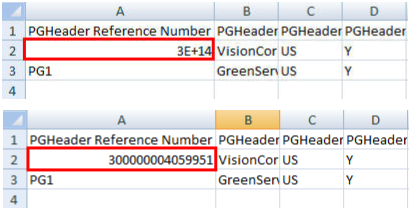Best Practices for Sales Catalog Setup
Sales catalog and product group setup can be quite complex. Therefore, be sure to follow the best practices described in this topic.
Here are the main best practice areas covered in this topic:
-
Importing product groups
-
Finding and entering reference numbers
-
Checking your work before publishing or importing
-
Locking and publishing product groups
-
Associating the product group root with the Base usage
-
Creating a new product group hierarchy
-
Running a scheduled process after changing Base usage
Import Product Groups
If your import file contains spelling and other errors, you can make your corrections in the same file and import again. The import process overwrites the existing entries.
Find and Enter Reference Numbers
Unique product group reference numbers can be used to establish the relationships between parent and child product groups in some import spreadsheets. You can find the reference number in the Reference Number column in the Manage Product Groups page.
In your import spreadsheet, be sure any numbers are formatted as numbers (versus, for example, formulas), with zero digits to the right of the decimal. Otherwise, the import process can't recognize them. For example, generally, when you paste the reference number into a spreadsheet, the spreadsheet will automatically format it as something other than a plain number. In order for the import process to recognize the number as a number, you may need to explicitly format it as a number (with zero digits to the right of the decimal).

Check Your Work Before Publishing or Importing
After you have published a product group, you can't delete it. You can only make it inactive. Thus, be sure to check your work before you publish the product groups you create in the UI and before you import. Importing publishes all unpublished product groups automatically, even those that aren't in your file.
-
Click on the root group name in the list and then click the tree view icon in the tool bar.
-
Check that the names are correct and that the hierarchy is set up as you want it.
Lock and Publish Product Groups
Any product group you want to edit must be "locked". You lock a group by selecting it in the UI and then clicking the Lock button. When you lock a product group, no one else can make changes to it until it's unlocked again.
Any product group hierarchy you want to use in consuming applications must be published. Publishing is done by clicking on the root node of the group and then clicking the Publish button or when you import your product group data file. When you publish, the application publishes all product groups that are locked. If you don't want some groups to be published, then you must unlock them.
Set Product Group Hierarchy Base Usage
The root product group you use for leads, opportunities, and territories must be assigned to a usage called "Base". You make this assignment in the Manage Product Group Usage page in Setup and Maintenance. Use the Manage Product Group Usage task to get to the page.
Create a New Product Group Hierarchy
If for some reason you don't want to use a product group hierarchy that you have created, you can always create a new root and subgroups, publish them, and associate the Base usage with the new product group root.
Run a Scheduled Process After Changing Base Usage
Each time you make a new assignment of Base to a root product group, you must run the scheduled process Refresh Denormalized Product Catalog Table for BI. If you don't run the process, your product group hierarchy may not appear in the consuming applications. Also, if you use future start or end dates for product groups, then you should schedule the refresh process periodically as well.